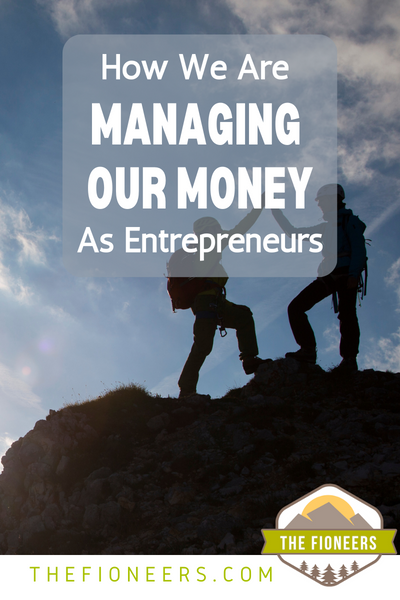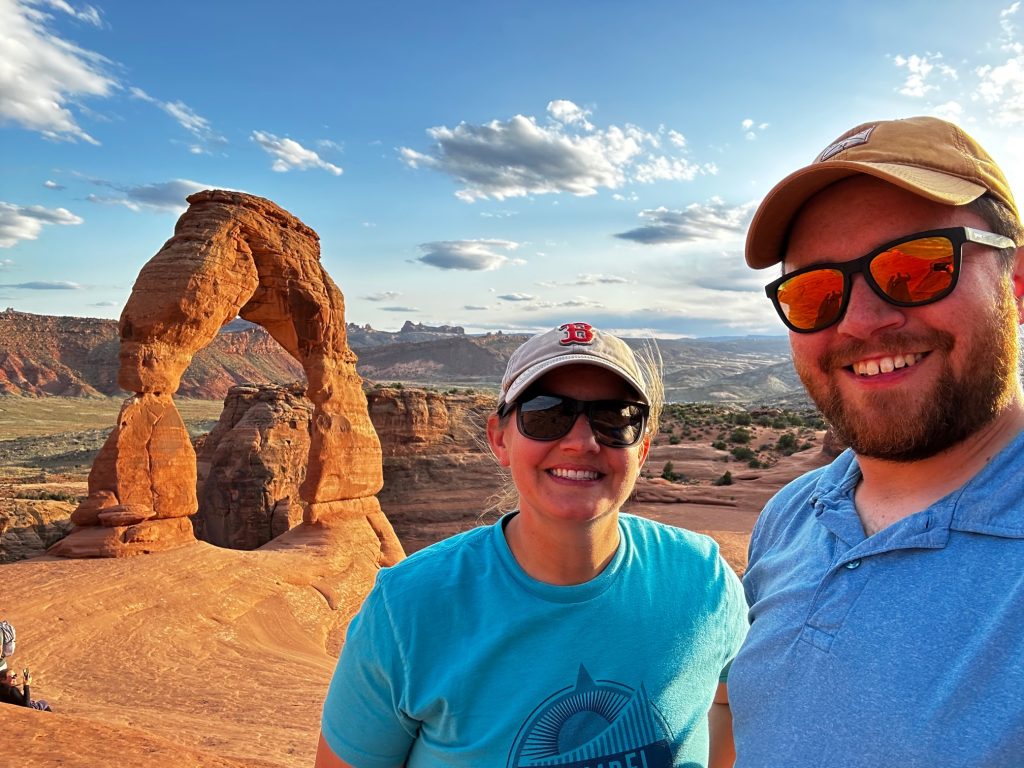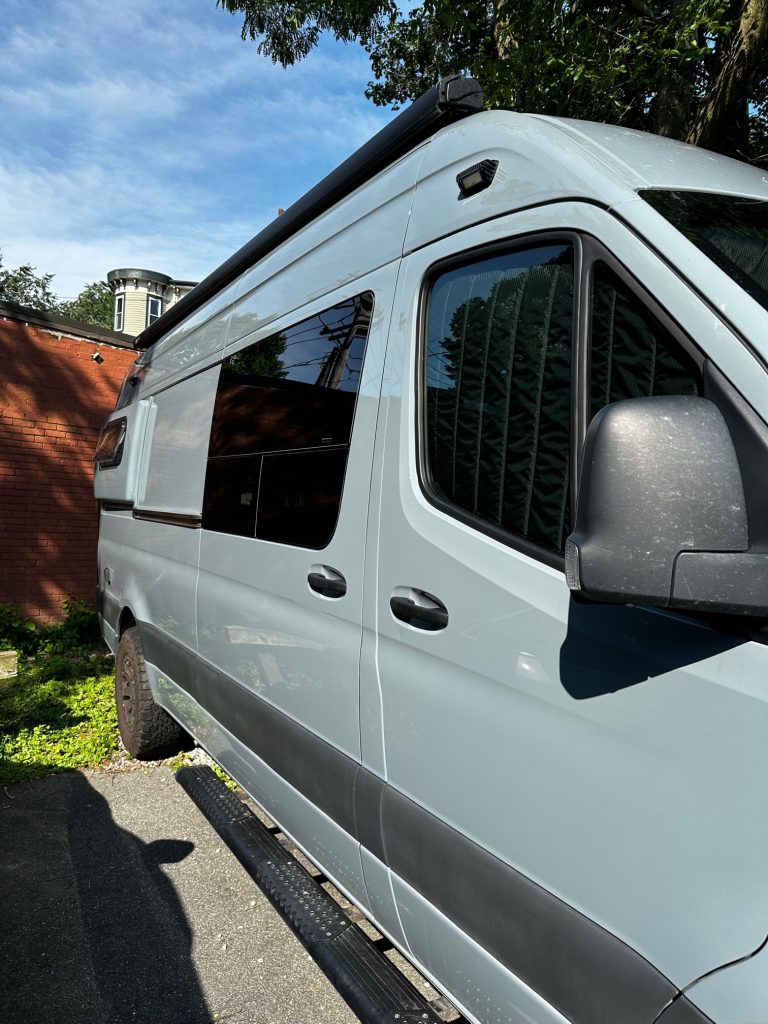

I’ve been an entrepreneur with a variable income for three years now. In some months, I make 5 figures in revenue. In other months, I make as little as $500. It can be difficult to manage your money as an entrepreneur with a variable income.
For the first two years as an entrepreneur, it wasn’t so difficult. My spouse, Corey was continuing to work full-time at a traditional job. His income was consistent and cushioned the impacts of my variable income.
But, things changed earlier this year. Corey quit his job in February. We are now relying on the variable income from the business cushioned by our cash reserves.
We’ve received a lot of questions about how we’ve made this transition. What are the nuts and bolts of our money management? Do we pay ourselves a salary? And, the question we’ve been asked most often is what are we doing for health insurance?
We’ve been managing our money as entrepreneurs for 5 months. Now, I’m ready to share more about how we are managing our money as entrepreneurs.
Our Money Management Strategy Supports Our Goals
Before I get into the strategy, I want to be clear that this money management strategy is unique to us and supports our goals. You may find helpful things that can apply in your own situation. Take it, and leave the rest.
For this year, our goal is simply to cover our expenses. We’ll do this through a combination of Corey’s earned income from the first two months of the year and income from our business. By our business, I’m talking about the courses, coaching, and retreats I run through the Fioneers.
We also built a cash runway, in addition to our emergency fund, that could help us cover any shortfalls.
For this year, this money management strategy allows:
- Us to travel in our campervan for 5-6 months this year
- Corey to take 6-9 months to focus on recovering from burnout and exploring new activities without the pressure of earning income
- Me to focus on maintaining (or slowly growing) the business, but doing it in less time since we are traveling more.
- Us to have minimal money stress even with a variable income.
How We Manage Our Money as Entrepreneurs
There are 4 key topics that I want to cover in this section:
- Emergency Savings and F-You Fund
- Business Income
- Savings and investments
- Health Insurance
Emergency Savings and F-You Money
As a general rule of thumb, people say it’s good to have 3-6 months’ worth of expenses as an emergency fund. I think of everything above that as my F-You Money.
F-You Money is liquid assets that you can use to get out of a bad situation or take advantage of an opportunity. For us, it’s the cash runway that provides time to build up a new income stream.
As entrepreneurs with a variable income, it’s important to keep a healthy cash runway. Right now, we have about 2 years worth of expenses available to us.
Given that we can cover most of our expenses from business income, this runway could last us a lot longer than two years. It also allows our investments to continue growing in the background.
In preparation for Corey quitting his job, we bulked up our cash runway. For the second half of 2022 and the first couple of months of 2023, we reduced Corey’s 401k contributions to only meet the match. This allowed us to send more of the money to our cash reserves.
Business Income
After working with a CPA earlier this year, we’ve learned that paying ourselves a salary helps us reduce our tax bill. It also helps to reduce the impact that the variability in revenue has on our daily lives.
We’ve chosen to pay ourselves the minimum wage ($15/hour) for our state based on the approximate number of hours we each work per week.
I know this seems low. We are okay with this because we also know that all the profits of the business are ours. We can take a disbursement from the business if we want or need to.
At this point, we are happy to keep a larger balance in the business account. These capital reserves give us the confidence that we’ll be able to cover our expenses and salaries, even if there’s a downturn in the business.
As we build our revenue and long-term confidence in our business, we could choose to increase our salaries later.
Savings and Investments
For 2023, we are not planning to save or invest. We do hope to increase our income in the future to the point where we could save or invest 20% of our income for retirement or other goals.
We are confident in this approach because we have achieved Coast FI. Being Coast FI means that if we never invested another dollar, our money would grow and allow us to fully retire, in our case, in our mid-50s.
Being Coast FI gives us the confidence to have a year (or a few years) where we simply cover our expenses or even use money from our cash runway.


Even if it takes us 2-3 years to get to a place where we can save and invest again, we still feel confident in our plans.
Because we do not plan to use our investments anytime soon, we have chosen a portfolio with 100% stock exposure. This will give us the greatest chance that our money will grow in the long term.
Health Insurance
We chose to buy our own health insurance through the Massachusetts Health Connector, our state’s equivalent to the Healthcare.gov marketplace.
Because I have a history of a variety of health problems, we were not comfortable using a health-sharing ministry or a high-deductible health plan.
We chose a Silver Tier plan that provides excellent coverage. Within this plan, we each have a $2,000 deductible and a $9,000 out-of-pocket maximum.
When we were originally considering leaving traditional employment, we put a $20,000 placeholder in our budget for health insurance. So many people had lamented the high cost of health insurance, and we weren’t sure what to expect.
Once we figured out the cost, we were pleasantly surprised. We only pay $800/month for both our medical and dental insurance. Paying $10,000 annually for health insurance is still quite high, and I wish we didn’t have to pay it. But, we see it as the price that we must pay for freedom from traditional employment (at least here in the USA).
Because we are self-employed, the cost of our health insurance is a business expense and tax deductible.
How We Are Managing Our Money Mindset
As entrepreneurs, it’s also important to manage our money mindset. It can be easy to fall into a scarcity mindset when you can only rely on yourself to generate the income needed. Here are a few strategies we’ve used to manage our money mindset, reduce pressure, and build our confidence.
Paying Ourselves from Last Year’s Profits
By having a large cash runway, I can do a little mental gymnastics and imagine that I’m covering this year’s expenses from last year’s profits. Then, I can tell myself that all the money I make this year can go toward funding next year’s life.
I don’t know why this mental framework is so helpful for me. But, it is. It takes away so much pressure from generating income. I know that I don’t actually need it right now. When the pressure is off, I also enjoy working in my business a lot more (and very likely make more money than if I were putting a lot of pressure on myself).
Tracking Our Net Worth
We’ve been tracking our net worth for many years. It’s a helpful visual to see that over time our wealth (and subsequently our freedom) has increased.
I recently took a look at our net worth and compared it to 5 months ago when Corey quit his job. Theoretically, I knew it would be higher. But, seeing the evidence that it continues to grow even when we are down to one income helps to build a lot of confidence.
Creating and Sharing Income Projections
It’s been very helpful to create income projections. This helps me to know how much I expect to make this year. I like to create different scenarios also. On the high side, I make note of what I would make if everything worked out exactly as I wanted it to. On the low side, I project what I’d make if things didn’t go as expected.
I obviously want the higher projection to come to fruition. Creating the lower projection helps take the pressure off. I can look at the low end and ask myself, “Will we be okay if this happened?” The answer is always yes, which builds my confidence.
Having these projections available helps Corey and me to be on the same page. Because he has an understanding of the likely income we’ll generate, he doesn’t need to feel the pressure to find work or start making money immediately.
Recognizing All the Ways We Could Make Money
When I start worrying about money, one thing that’s always helpful is to come up with a list of all the different ways that we could make money. We know that we aren’t limited to our current income streams.
Here are a few ideas on our list:
- Build up and monetize our YouTube Channel
- Rent out our house while we travel
- Rent out our campervan when we are home
- Gig work
- Create new products or services to sell
- Selling items in our house (we’ve been doing this recently as we’ve been decluttering)
- Find temporary, contract, or freelance work
Our minds can easily go to the worst-case scenario. It’s helpful to realize that there are so many options available to us before we would get to that point.
Doubling Down on Intentional Spending
When experiencing a scarcity mindset, the tendency can sometimes be to not buy anything, even if it will dramatically improve our quality of life.
Instead, we are doubling down on intentional spending. In the words of Ramit, our goal is to “spend extravagantly on the things we value and mercilessly cut costs on the things we don’t.”


We’ve made a few big purchases recently that will add tremendous value to our lives. We’ve made a few upgrades to the van, including adding a window, a storage box, and bike mounts, and mounting our Starlink to the roof.
We also recently purchased e-bikes. After renting e-bikes in the Grand Canyon earlier this year, we realized how much we enjoyed exploring this way. While we enjoy biking long distances when it’s flat, we enjoy it a lot less when there are a lot of hills to climb. So, we decided to invest in e-bikes.
At the same time, we are mercilessly cutting costs on the things we don’t value. We’ve cut our spending on restaurants, take-out, convenience, clothing, and “general merchandise”.
Transitioning from Accumulation to Enjoyment
We’ve heard from so many people that it’s difficult to make the transition from saving a significant portion of your income to enjoying your freedom.
This has been a challenge for us too, which is why we’ve chosen an incremental approach.
Until 2020, we focused on increasing our savings rate. We topped out saving about 60% of our income.
In 2021 and 2022, we reduced our savings rate by quite a bit. We kept our income roughly the same, but we spent a lot more money. We bought and built out our campervan over those two years, which brought our savings rate down to about 20%.
Now in 2023, we’re scaling down even more. We don’t have as many large purchases as in the last two years, so we’re scaling back by reducing our income. We have no expectations to save or invest this year.
We may save money in future years, but we won’t ever need to save 50% of our income ever again.
This incremental approach will help us when we eventually transition to the decumulation phase and actually start living off our nest egg.
We’re already building the “muscles” needed to enjoy the freedom that we have rather than feeling like we constantly need more.

























In the financial labyrinth of entrepreneurship, we wield creativity as our compass. Imagine a financial garden where each investment is a seed nurtured by strategic watering. We sculpt budgets like artisans, allocating resources like strokes of paint on a canvas.
Just as a captain navigates uncharted waters, we steer through market currents. The currency of risk is traded for the coin of opportunity, while diversification stands as our shield.
Picture the ledger as a journal of triumphs and setbacks, each entry a lesson etched in ink. In this fiscal adventure, we script success with ink made of resilience and innovation.